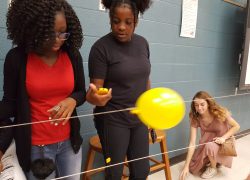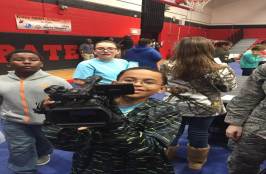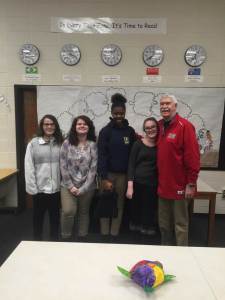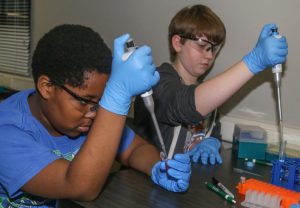Month: February 2018
Full STEAM Ahead with Project Based Learning
All aboard and Full STEAM Ahead!

The educators over at Bates Middle School in Sumter, South Carolina have been working hard laying tracks for the past year in order to bring their exciting project to fruition. By combining Project Based Learning (PBL) and a curriculum focus on Science, Technology, Engineering, the Arts and Mathematics (STEAM) and working with local businesses they are hoping to create a new generation of students who are prepared to be in an agile and competitive work force. One of the brilliant concepts behind this project is that nothing exists in a vacuum. You can’t well understand engineering if you don’t have a good handle on physics. You can’t code a videogame without understanding the underlying code. And you certainly can’t have music without math.
The Full STEAM Ahead project aims to remove the traditional isolation of subjects through the use of the “Critical C’s” of Collaboration, Cooperation and Communication which are emphasized with project based learning through interdisciplinary activities.
Now that they are a year in, let’s see what has transpired.
Bates teachers, led by the Transforming Learning Together (TLT)

mentor teachers, in the first stage of this initiative begun by identifying large-scale student learning goals for the year. They then researched new teaching approaches in order to integrate STEAM and Project Based Learning to help them achieve their goals, along with developing “action plans” for each year’s practice. The belief was that art can spark creativity in young scientists and engineers, develop observational abilities, and strengthen collaborative skills. One of the guiding questions for this project is ” How can we improve instruction, pedagogy, and student learning across the curriculum through the use of STEAM and PBL?”

So how do they propose to do this?
They began by having their trainers and the TLT team attend a PBL and STEAM workshop that spaned six sessions. This team returned to Bates to lead the entire staff through a STEAM Project Based Learning activity in order to familiarize everyone with the methods. Teachers investigated and utilized critical inquiry to work through this challenge. The thinking was that teachers will experience everything that the students do, giving them the tools to help elevate the projects as well as answer previously unanticipated questions. Teachers then guided students through one PBL unit in the first year of implementation.
A year in… where are they now?
They started off by providing professional development to their teachers during the first semester of the school year. STEAM lessons were developed to be a part of the regular curricula as well as embedded in Project Based Learning. The second semester brought about school-wide PBL units. Then on March 24th, there was a school-wide PBL Kickoff to begin the grade level units. This is where things really began to take off. For this initial thrust into the unknown they gave each year a different subject field to dig into. Sixth graders explored the guiding question: “Are animals placed in captivity at an advantage or disadvantage than those in their natural habit? Why/ Why not?”

The kick-off was a field trip to the Riverbanks Zoo. The 6th graders researched the question and created suitable habitats for animals of their choice. The 7th graders explored the guiding question: “How can we be prepared for the unexpected?” Dealing with the preparedness for natural or man-made disasters was the focal point. The Red Cross, Fire Department, EMS, Disaster Management, Police Department, Shaw AFB and Salvation Army each set up a station to explain their role in disasters and how the community can prepare for disasters in the future. Students researched a disaster and prepared community service presentations on disaster preparedness. Eighth graders explored the, very relevant, guiding question: “Can separate be equal?” This question dealt with the Civil Rights movements of 1960 -1990. Guest speakers, Nathaniel Briggs (Briggs vs. Elliot) and Artrell Benbow (civil rights activist in Summerton and Sumter) spoke to the students of their personal experiences. This culminated with the 8th grade Drama class presenting a skit about the infamous Orangeburg Massacre. Students then rotated rooms to watch films about civil rights, explored civil rights virtual museums, and participated in gallery walks. Students researched the civil rights eras of 1960’s through the 1990’s and created projects to address the guiding question. The PBL classes occurred every Tuesday and Thursday beginning March 28th and ended in a PBL Excellence Fair held on May 4th at 6:00 pm at BMS to showcase student work and presentations.
What are some challenges facing STEAM/PBL learning?

For as exciting as this method of PBL learning is, and it’s clear that it’s starting to work; students and teachers on the whole are more engaged in their study areas… it’s not without it’s challenges. One of the biggest cited in the report is that not all of the teachers have bought into the STEAM /PBL concept. This makes communicating those ideas to students that much harder. Further professional development is needed in order to ensure more participation by teachers. They have also had some difficulty setting up model classrooms so we are hoping teachers observing other teachers will assist in this. But as more teachers undergo professional development and find the merit in this method of teaching the easier it will get. And year two has some exciting things in store for the students. One word: Robots. We look forward to hearing about their experiences with Robots.
How might Robots, cross-cultural references and civil rights intersect?

Let’s mix up that engineering and art a bit, shall we? The term “robot” came from a Czech play called Rossums Universal Robots and is derived from the word “robotnik” which means slave. It’s about a robot who is forced to work for a shady company that then rebels and leads to the extinction of the human race. It’s bleak, but not without hope. But it’s a good lesson and a challenge for students on how we should be thinking about a newly created servant class. Just some food for thought.
Learn more
- STEAM, not STEM
- STEAM Rising: Why we need to put the arts into STEM education
- Project-Based Learning: PBL is a dynamic classroom approach in which students actively explore real-world problems and challenges and acquire a deeper knowledge
- Project-Based Learning: Students actively investigate solutions to complex, long-term challenges, often in groups

